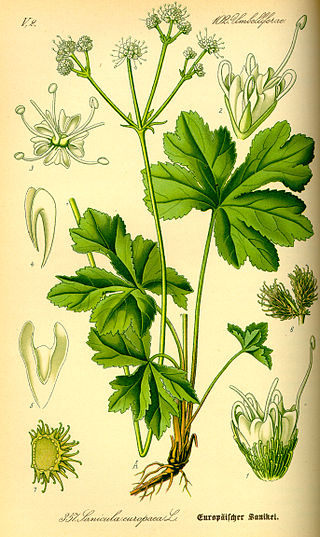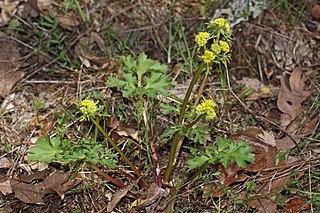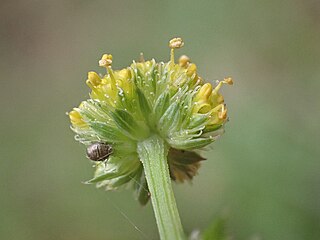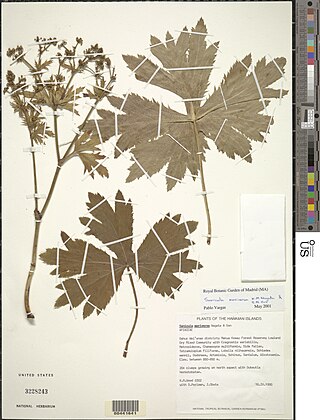
Sanicula is a genus of plants in family Apiaceae, the same family to which the carrot and parsnip belong. This genus has about 45 species worldwide, with at least 22 in North America. The common names usually include the terms sanicle or black snakeroot.
The Species at Risk Act is a piece of Canadian federal legislation which became law in Canada on December 12, 2002. It is designed to meet one of Canada's key commitments under the International Convention on Biological Diversity. The goal of the Act is to prevent wildlife species in Canada from disappearing by protecting endangered or threatened organisms and their habitats. It also manages species which are not yet threatened, but whose existence or habitat is in jeopardy.

Sanicula bipinnata is a species of plant in the family Apiaceae known by the common name poison sanicle. It is endemic to California where it is found in low-elevation mountains and foothills, especially in the hills along the coast. It occurs in the California Coastal Range and Sierra Nevada foothills, including Ring Mountain, California.

The wildlife of Canada or biodiversity of Canada consist of over 80,000 classified species, and an equal number thought yet to be recognized. Known fauna and flora have been identified from five kingdoms: protozoa represent approximately 1% of recorded species; chromist ; fungis ; plants ; and animals. Insects account for nearly 70 percent of documented animal species in Canada. More than 300 species are found exclusively in Canada.

Sanicula arguta is a species of flowering plant in the family Apiaceae known by the common names sharptooth sanicle and sharptooth blacksnakeroot.

Sanicula crassicaulis is a species of flowering plant in the family Apiaceae known by the common names Pacific black-snakeroot and Pacific sanicle.

Sanicula graveolens is a species of flowering plant in the family Apiaceae known by the common names northern sanicle and Sierra blacksnakeroot. It is native to western North America from British Columbia to Montana to California, and southern South America, including southern Chile. Its habitat includes mountain slopes, forests, and woodlands on serpentine soils. It is a perennial herb producing a slender, branching stem up to half a meter tall from a taproot, with leaves alternate. The lowest leaves have long stalks and are often attached below ground. The upper leaves are smaller, sparse and often sessile. The leaves are compound, the blades each divided into three deeply lobed, toothed leaflets. The herbage is green to purple-tinged to all purple in color. The inflorescence is made up of one or more heads of bisexual and male-only flowers with tiny, curving, yellow petals. Each head has an array of narrow, toothed bracts at its base. The rounded fruits are a few millimeters long, covered in curving prickles, and borne in small clusters.

Sanicula hoffmannii is an uncommon species of flowering plant in the family Apiaceae known by the common names Hoffmann's blacksnakeroot and Hoffmann's sanicle. It is endemic to California, where it is known from the Channel Islands and a few locations in the coastal mountain ranges of the mainland, including the Scott Creek watershed in Santa Cruz County. Its habitat includes coastal hillsides and mountain slopes, sometimes with serpentine soils. It is a perennial herb producing a thick stem up to 90 centimeters tall from a taproot. The green or bluish leaves are compound, the blades each divided into about three lobed, toothed leaflets. The inflorescence is made up of one or more heads of bisexual and male-only flowers with tiny, curving, yellow-green petals.

Sanicula maritima is a rare species of flowering plant in the parsley family known by the common names adobe snakeroot and adobe sanicle.

Sanicula peckiana is an uncommon species of flowering plant in the family Apiaceae known by the common names Peck's blacksnakeroot and Peck's sanicle. It is native to the Klamath Mountains of southern Oregon and far northern California, where it grows in chaparral and woodland habitat, often on serpentine soils. It is a perennial herb growing to a maximum height near 40 centimeters. The leaves are simple or divided into a number of lobes, the edges generally with sharp teeth. The inflorescence is made up of one or more heads of bisexual and male-only flowers with tiny, curving, yellow petals. The fruits are borne singly or in heads of up to five, each fruit covered in bumpy tubercles and sometimes with prickles near the tip.

Sanicula saxatilis is a rare species of flowering plant in the parsley family known by the common names devil's blacksnakeroot and rock sanicle.

Sanicula tracyi is a species of flowering plant in the family Apiaceae known by the common names Tracy's blacksnakeroot and Tracy's sanicle. It is endemic to northwestern California, where it is known from woodlands and coniferous forest in hills and mountains. It is a perennial herb producing a slender stem up to about 60 centimeters tall from a taproot. The leaves are compound, divided into usually three leaflets which are deeply cut into lobes and serrated along the edges. The herbage is green to purple in color. The inflorescence is made up of one or more heads of bisexual and male-only flowers with tiny, curving, yellow petals. The fruits are 2 or 3 millimeters long, each fruit covered in bumpy tubercles and sometimes with prickles near the tip.

Sanicula tuberosa is a species of flowering plant in the parsley family known by the common name turkey pea. It is native to western North America from Oregon through California to Baja California, where it can be found in many types of habitat, including chaparral, forests, and woodlands. It is variable in appearance. In general, it is a perennial herb producing a slender stem up to 80 centimeters long from a small, spherical tuber no more than 2 centimeters wide. The leaves are compound, divided into usually three leaflets which are smooth or deeply cut into lobes. The herbage is green to purple in color. The inflorescence is made up of one or more heads of bisexual and male-only flowers with tiny, curving, yellow petals. The fruits are 1 or 2 millimeters long and covered in bumpy tubercles.

Viola praemorsa is a species of violet known by the common names canary violet, Astoria violet, yellow montane violet, and upland yellow violet.

Sanicula mariversa is a rare species of flowering plant in the family Apiaceae known by the common name Waianae Range black-snakeroot. It is endemic to Hawaii, where it is known only from the Waianae Mountains on the island of Oahu. It is threatened by the degradation of its habitat. It is a federally listed endangered species of the United States.

Sanicula purpurea is a rare species of flowering plant in the carrot family known by the common names purple-flower black-snakeroot and purple-flowered sanicle. It is endemic to Hawaii, where it is known from Maui and from the Koolau Mountains on the island of Oahu. It is threatened by the degradation of its habitat. It was federally listed as endangered species of the United States in 1996.

The Victoria Harbour Migratory Bird Sanctuary or VHMBS is a 30 km protected area on the southern tip of Vancouver Island, Canada, in the Greater Victoria metropolitan area. It is located within the traditional territory of the Lekwungen People. The sanctuary is federally recognized as a critical habitat for bird conservation, and is home to an estimated 270 bird species, many of which are migratory. The sanctuary encompasses about 30 kilometres of coastline, an area covering approximately 1841 hectares in total. Of this total, 31 hectares are terrestrial, and 1810 hectares are marine.

Castilleja victoriae is a species of flowering plant in the broomrape family known by the common names Victoria's owl-clover and Victoria's paintbrush.



















